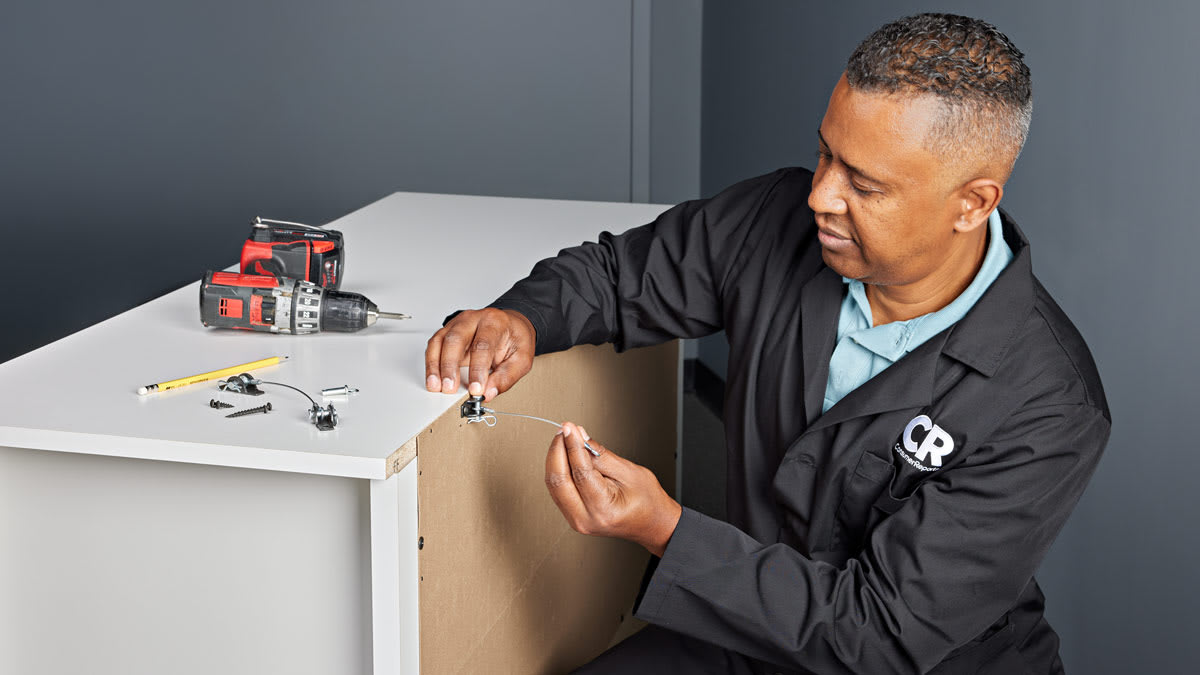
CR’s advice for anchoring furniture has always been: Find the stud. Don’t just anchor it into a hollow stretch of drywall, even with those expanding plastic plugs that are specifically meant for this wall material. Those are fine for hanging art because it pulls against the anchor only with a downward force. But they won’t cut it in a furniture tip-over scenario, which would be a heavy force pulling outward, away from the wall. This round of tests proves that point.
Even though nine of the anchor kits we tested included hardware and instructions for use on hollow walls, only three of them could withstand 60 pounds of force.
Take the kit that comes with the Ikea Malm 6-Drawer Dresser, which includes metal brackets and plastic drywall anchors, washers, and screws. When drilled into wood studs, the kit resisted an impressive 329 pounds. But when tested on hollow drywall with the plastic anchors, it ripped out of the wall at 58 pounds. Likewise, the kit supplied with the Hemnes 8-Drawer Dresser stood up to 302 pounds in wood studs, but the anchor popped out of drywall after only 41 pounds.
Ikea declined to comment on CR’s test results but said that its own tests showed that its furniture and anchors meet industry standards. Ikea did not answer CR’s question about whether or not it had considered including language in the assembly instructions that would indicate to consumers anchoring to a stud is stronger than attaching to hollow drywall.
“When manufacturers include drywall anchors with their kits, it makes it so easy for consumers to install them that way—but we think they shouldn’t,” Amézquita says. “If they didn’t include that hardware, people would know not to put them in hollow walls. You should always have a backing of solid wood, or metal, or concrete—something like that.”
Aside from the new law for dressers, there’s also a voluntary industry standard for the anchor kits themselves, indicating that they must withstand 60 pounds of static tension before breaking. But that standard doesn’t necessarily simulate what happens when they are attached to a wall and a piece of furniture. Our tests showed that some kits have strong components but weak attachment points. This was particularly obvious when we tested anchors in hollow drywall.
For instance, the Qdos Zero Screw Furniture Anti-Tip Kit failed at 57 pounds, the Lomily Furniture Wall Anchor Straps failed at 48 pounds, and the Yeya Furniture Strap Anchors failed at just 30 pounds. The Qdos is also notable for being incredibly complicated to install and didn’t perform as well as others we tested even when screwed into studs. And the Yeya, whose straps snapped apart easily in every test we put it through, happens to be the most expensive kit we bought, at $26 for a two-pack. Yeya did not respond to CR’s request for comment.
“CR’s test results demonstrate that not all anchoring kits are as strong or reliable as they need to be—and that can put children at risk,” says Gabe Knight, senior policy analyst at Consumer Reports. “While some performed extremely well, others, including some more expensive options, didn’t. Consumers deserve a strong mandatory performance standard that all anti-tip kits should have to meet.”









